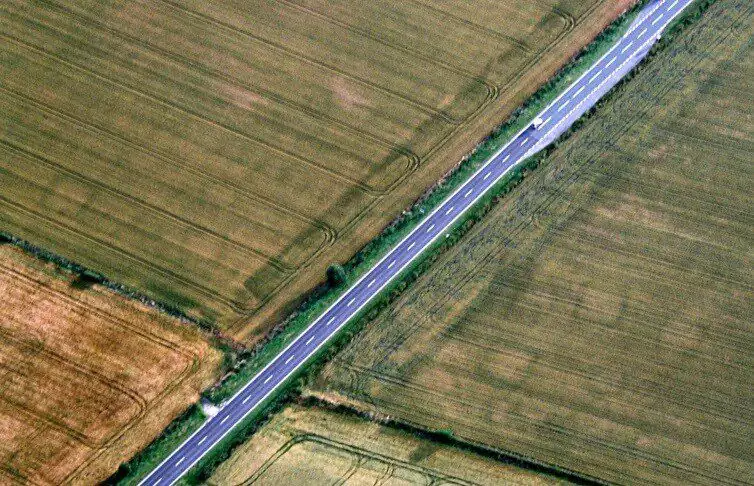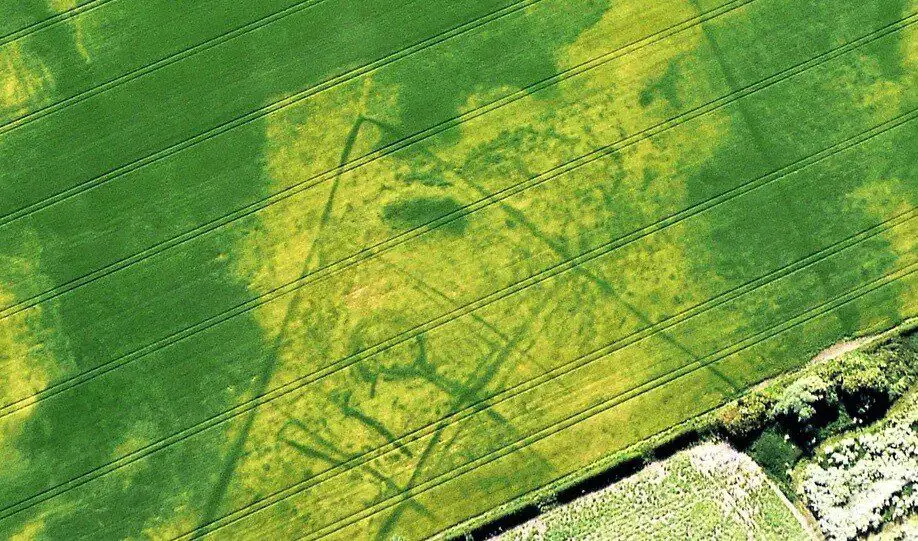For an aerial archaeologist 2018 has been a bumper year. The long, hot summer has revealed ancient landscapes not visible from ground level, but easily recognised in fields of growing crops from the air.
The principle behind the appearance of cropmarks is simple. If, for example, an Iron Age farmer dug a ditch around his field, over time this ditch will fill up with soil and other debris and will generally retain more moisture than the soil or bedrock it was cut into.
Centuries later, a cereal crop sown over this earth will grow for a longer period and ripen more slowly, appearing greener as the surrounding crop ripens to a golden colour. Conversely, a crop planted in soil covering the remains of a stone building or roadway will ripen more quickly and parch, again appearing a different colour to the rest of the crop.
What has made the summer of 2018 so remarkable is that the winter and spring was so wet that plants grew relatively shallow roots, having no need to search deeply for water. So when the drought came this summer, those plants that grew over buried features such as ditches and pits benefited from the greater store of water retained in the infilled soil.
Well-drained sandy soils and those over chalk are particularly conducive to revealing features through cropmarks.

Recognising archaeological sites by cropmarks is noted as far back as the antiquarians of the 17th century, although it was William Stukeley – who pioneered the study of Stonehenge and Avebury – who provided the clearest early explanation in his description of features in the Roman town of Great Chesterford in Essex in 1719. In the modern era, at first using balloons, then aeroplanes and, most recently, drones, aerial archaeology photography has become a standard reconnaissance technique.
History from the air
One area where this has been used widely is the Yorkshire Wolds, among the first to be covered in the National Mapping Programme undertaken by the former Royal Commission on Historical Monuments England, begun in 1908, now part of Historic England.
Compiled from thousands of aerial photographs by Cathy Stoertz and published as Ancient Landscapes of the Yorkshire Wolds in 1997, this remains one of the most detailed studies of an archaeological landscape in the UK. From the River Humber at Hessle to Flamborough Head, Stoertz’s mapping revealed a network of prehistoric and Romano-British enclosures, burials mounds, ceremonial monuments and linear earthworks.

My own research has examined many of these sites on the ground through geophysical survey and excavation, and further aerial sorties, and this has greatly expanded our knowledge of the region. Flying from Hull Aero Club’s airfield near Beverley, I have focused on the western escarpment of the Yorkshire Wolds and the eastern fringes at the Vale of York, a region I have studied for many years.
For example, the picture above shows the square barrow cemetery at Arras, in East Yorkshire. Here, burials were placed on the ground and a mound was built over them with soil dug out from a surrounding ditch. The barrow ditches show as green squares. Dating from the Middle Iron Age, probably around 300 BC, this site gave its name to the internationally recognised Arras Culture of East Yorkshire.
A portion of the massive later prehistoric earthworks of Huggate Dykes has survived since the banks and ditches were built in around 1000 BC, probably as territorial boundaries or as a means to control access to springs and streams.

Impressive from ground level, an aerial view reveals faint green stripes in an adjacent cornfield – all that is left of the buried ditches after centuries of ploughing.
This year I have discovered hitherto unknown sites and, in other places, greater detail at already recorded sites. These include Bronze Age round barrows, apparent as rings in the crop, the characteristic square barrows of the Iron Age Arras Culture, and linear features running across the landscape from Iron Age and Romano-British farmsteads and other settlements.

Collaborating with Tony Hunt of Yorkshire Aerial Archaeology and Mapping, for the first time I have also used drones. Although these are subject to altitude restrictions, a good quality camera on a drone guided along pre-programmed tracks by GPS can gather precise images. The hundreds of overlapping images can be combined to provide a huge two-dimensional mosaic image, or processed to create 3D imagery, an elevation model, or to colourise the images in order to make the hidden archaeological features more visible.
This technique is truly revolutionary as mapping was tricky and time-consuming in the past, particularly aerial photographs taken at oblique angles, requiring hours peering through a stereoscope, mapping sites by hand using geometry.
While the drought of 2018 has seriously affected crop yields, it has provided a rich harvest of a different kind, one that will take a considerable time to digest. An opportunity to do so will be as archaeologists meet to discuss finds from across Europe at the Aerial Archaeology Research Group annual conference, held this year in Venice, September 12-14.
Written by Senior Lecturer in Archaeology, University of Hull
Header Image – Unseen from ground level, this Iron Age farmstead with recognisable round house near the Yorkshire Wolds is revealed in cropmarks. The lighter green shows it was carefully placed on a gravel rise surrounded by wetter land, shown here where the crop grows a darker green. Credit : Peter Halkon
![]()





